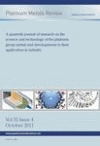-
oa Recovery of Platinum Group Metals from High Level Radioactive Waste
Possibilities of Separation and use Re-Evaluated
- Source: Platinum Metals Review, Volume 35, Issue 4, Oct 1991, p. 202 - 208
-
- 01 Jan 1991
Abstract
When nuclear fuel is irradiated in a power reactor a wide range of chemical elements is created by the fission of uranium and plutonium. These fission products include palladium, rhodium and ruthenium, and could in principle constitute a valuable source of these three metals. Their separation front the fuel during reprocessing operations is, however, a complex mutter. Various processes have been proposed and evaluated, mainly on a laboratory scale. To date none of them has been established as applicable on a commercial scale, but investigations with this aim are continuing in several countries. Even a complete separation of the platinum group metals from other nuclides would yield a radioactive product, because of the presence of active isotopes of the platinum group metals. These would be expected to restrict the practical utilisation of platinum group metals created by nuclear fission, unless an isotope separation technique can be developed, or the metals are stored until the radioactivity has decayed.


